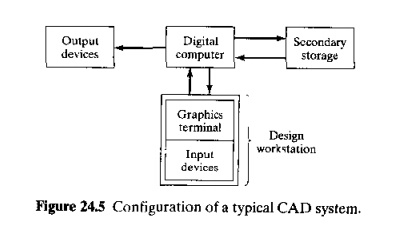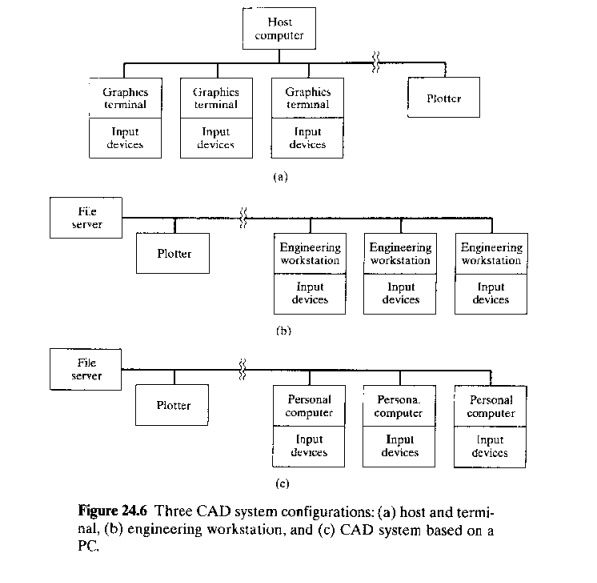Chapter: Automation, Production Systems, and Computer Integrated Manufacturing : Product Design and CAD/CAM in the Production System
CAD System Hardware
CAD SYSTEM
HARDWARE
The
hardware for a typical CAD system consists of the following
components: (1) one or more design workstations, (2) digital computer, (3)
plotters, printers. and other output devices. and (4) storage devices. The
relationship among the components i, illustrated in Figure 24.S.ln addition,
the CAD system would have a communication interface to permit transmission of
data to and from other computer systems. thus enabling some of the benefits of
computer integration
Design
Workstations. The workstation is the interface between computer
and
user in the
CAD system. Its functions are the following: (1) communicate with the CPU. (2) continuously generate
a graphic image. (3) provide
digital descriptions of the image, (5) translate user commands
into operating functions, and (5) facilitate interaction between the user and
the system.
The
design of the CAD workstation and its available features have an important
influence on the convenience, productivity. and quality of the user's output.
The workstation must include a graphics display terminal and a set of user
input devices. The display terminal must be capable of showing both graphic~
and alphanumeric text. It is the principal means by which the system
communicates with the user. For optimum graphics display, the monitor
should have a large color screen with high resolution.
The user
input devices permit the operator to communicate with the system. To operate
the CAD system,
the user must be able to accomplish the following: (1) enter alphanumeric data,
(2) enter commends to the system (0 perform
various graphics operations, and (3) control the cursor position on the display
screen. To enter alphanumeric data, an alphanumeric keyboard is provided. A
conventional type writer like keyboard allows the designer to input numerical
and alphabetic characters into the system. The alphanumeric

keyboard
can also be used to enter commands and instructions to the system. However.
other input devices accomplish this function more conveniently. Special function keypads have been developed to
allow entry of a command in only one or two keystrokes. These special keypads
have from 10 to 50 function keys, depending on the system. However, each key
provides more than one function, depending on the combination of keys pressed
or which software is being used. Another input device for entering commands to
a CAD system is the electronic tablet,
an electronically sensitive board on which an instruction set is displayed,
arid commands arc entered using a puck or electronic pen.
Cursor control
permits the operator to position the cursor on the screen to identify a
location where some function is to be executed. For example, to draw a straight
line on the screen, the endpoints of the line can be identified by locating the
cursor in sequence at the two points and giving the command to construct the
line. There are various cursor control devices used in CAD, inducting pucks, mouse’s,
joysticks, trackballs, thumbwheels, light pens, and electronic tablets. An
input device for entering coordinates from an existing drawing into the CAD
system is a digit/t.er, which
consists of a large flat board and an electronic tracking element such as a
puck that can be moved across the surface of the board to record x and y-coordinate
positions.
Digital
Computer. CAD applications require a digital computer with a high-speed central
processing unit (CPU), math coprocessor to perform computation intensive
operations, and large internal memory. Today's commercial systems have 32bit
processors, which permit high-speed execution of CAD graphics and engineering
analysis applications.
Several
CAD system configurations are available within the general arrangement shown in
Figure 24.5. Let us identify three principal configurations, illustrated in
Figure 24.6: (a) host and terminal, (b) engineering workstation, and (c) CAD
system based on a personal computer (PC).
The host and terminal was the original CAD
configuration in the Ig70s and early 1980s when the technology was first
developing. For many years, it was the only configuration available. In this
arrangement, a large mainframe computer or a minicomputer serves as the host
for one or more graphics terminals. These systems were expensive, each
installation typically representing an investment of a million dollars or more.
The powerful microprocessors and high-density memory devices that are so common
today were not available at that time. The only way to meet the computational
requirements for graphics processing and related CAD applications was to use a
mainframe connected 10 multiple terminals operating on a timesharing basis.
Host and terminal CAD systems are still used today in the automotive industry
and other industries in which it is deemed necessary to operate a large central
database.
An engineering workstation is a standalone
computer system that is dedicated to one user and capable of executing graphics
software and other programs requiring high-speed computational power. The
graphics display is a high-resolution monitor with a large screen. As shown in
our figure, engineering workstations are often networked to permit exchange of
data files and programs between users and to share plotters and data storage
devices.
A PC-based CAD system is a PC with a high-performance
CPU and medium to high resolution graphics display screen. The computer is
equipped with a large random access memory (RAM), math coprocessor, and large capacity
hard disk for storage of the large applications software packages used for CAD.
PC-based CAD systems can be networked 10 share file" output devices, and
for other purposes. Starting around 1996, CAD software developers began
offering products that utilize the excellent graphics environment of Microsoft
Windows NT, thus enhancing the popularity
and familiarity of PC-based CAD.

When the
engineering workstation is compared with the PC-based system, the former is
superior in terms of most performance criteria. Its capacity to efficiently
accomplish 3D geometric modeling and execute other advanced software exceeds
that of a PC, and this makes the workstation more responsive and interactive
than a PC-based CAD System. However, the performance characteristics of PCS are
improving each year, and the prices of engineering workstations are dropping
each year, so that the distinction between the two types is becoming blurred.
Plotters and Printers, The CRT
display is often the only output device physically located at the CAD
workstation. There is a need to document the design on paper. The peripherals
of the CAD system include one or more output devices for this purpose. Among
these output devices are the following
Pen plotters. These are .x y plotters
of various types used to produce high accuracy line drawings.
Electrostatic
plotters. These are faster device, based on the same technology as photocopying.
The resolution of the drawings from electrostatic plotters is generally lower
than those made by a pen plotter.
Dot-matrix
printers. In the operation of these printers, small hammers strike an ink ribbon against the paper to form a
drawing consisting of many ink dots.
Inkjet
printers. These arc similar to dot-matrix printers except that the dots arc formed by high-speed jets of ink
impacting the paper.
Storage Devices. Storage peripherals
are used in CAD systems to store programs
and data files. The storage medium is usually a magnetic disk or magnetic
tape, Files can be retrieved more quickly from magnetic disks, which
facilitates loading and exchange of files between CPU and disk. Magnetic tape
is less expensive, but more time is required to access a given file due to the
sequential file storage on the tape. His suited to disk backup, archival files,
and data transfer to output devices.
Related Topics